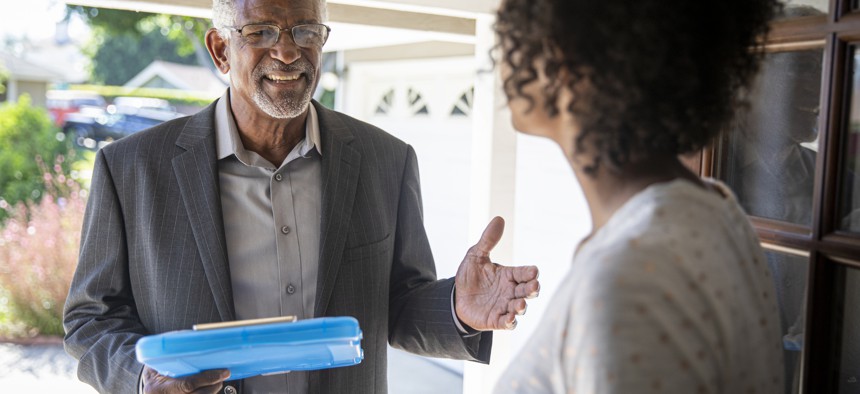City’s ‘Displacement Prevention Navigators’ Aim to Help Neighbors Remain in Homes

adamkaz via Getty Images

Connecting state and local government leaders
Austin, Texas, will train city residents to help people find the resources they need to stay in their homes when rents and property taxes rise.
When people are on the verge of losing their homes, it can be difficult to sift through all the municipal resources available to them and understand eligibility criteria, particularly while balancing work, child care and financial pressures. To provide some assistance, the city of Austin, Texas is hiring community members to help neighbors navigate programs to stay in their homes.
Austin is one of the fastest-growing cities in the country, and its recently-launched Displacement Prevention Navigator pilot program aims to help residents remain in their homes, especially as rents, home prices and property taxes rapidly increase with the city’s growth.
The city plans to hire and train 12 to 15 “navigators” who will engage with residents and help them understand and access housing resources, often working one-on-one or in small group settings. Such tasks could include helping residents learn what kinds of programs are available, which have the shortest waitlists, and understanding which applications to prioritize. They will also help with the application processes by guiding residents through tasks like creating an email address in one-on-one or small-group settings.
Outreach will likely take many forms, including mailers and door-hangers informing residents the program exists, sending navigators out to go door to door to connect with residents, and attending community events, according to program manager Cara Bertron.
The pilot program will roll out in two neighborhoods—Colony Park and Dove Springs—that have higher rates of cost-burdened residents compared to the rest of Austin, meaning more than 30% of their income goes to housing costs. The two areas are poised for redevelopment that could increase property values and push current residents out.
Project Connect, for instance, is an initiative that will expand transit city-wide, including in Colony Park and Dove Springs. While the project will benefit the two neighborhoods, it could also be a development that leads to increased displacement.
Nearly one-third of Austin homeowners spend more than 30% of their income on housing. But in Colony Park and Dove Springs, the share is much larger, according to the city. In Colony Park, 66% of homeowners and 93 percent of renters spent high portions of their income on housing, and in Dove Springs, 62% of homeowners and 55 % of renters exceeded the recommended amount of their income on housing.
Bertron noted that those figures are based on 2020 census data.
These communities are notable for the amount of time residents have been in the area, with nearly half of Colony Park residents having lived in the neighborhood for more than 20 years.
Keeping residents in their homes isn’t just good for those households and families, Bertron said. It benefits the greater community over time.
“It's good for the city to have people who are longtime residents and who are invested in their neighborhoods and communities,” she said. “That leads to stronger and healthier and more vibrant communities in Austin and in other cities that have grown really rapidly.”
The initiative also aims to help residents overcome some of the barriers to accessing housing resources. Insufficient digital literacy, for example, is a barrier to accessing online resources, but it’s difficult to know just how far-reaching that challenge is, Bertron said.
With $360,000 in funding for its first year, the program will hire navigators who will work 10 to 15 hours a week for a year and earn $25 per hour. Anyone can apply for the position, but the city is primarily looking to hire people with connections to Colony Park or Dove Springs. That could include living, working or sending children to school in those neighborhoods.
The application deadline is Sunday, and so far the city has received nearly 170 applications from those interested in becoming navigators, Bertron said.
“The community interest is definitely there,” she said. That interest is encouraging when considering the future of the program, which may include expanding into other neighborhoods, Bertron said. But it’s not yet entirely clear what will happen after the pilot ends. The initiative could move into other targeted neighborhoods or across the entire city. Or the city might decide that the best way to move forward might mean supporting community organizations to carry the work onward.
The other goal is to get a better understanding of the barriers people face when it comes to accessing city resources, Betron said. The city might find that by streamlining applications and making resources more navigable, it could reduce the need to have navigators working directly with residents.
The navigator system won’t solve all the housing problems, Betron said, noting that Austin must develop more affordable and mixed-income housing, create incentives for development and support homeowners in building accessory dwelling units. The Displacement Prevention Navigator program is one piece of that puzzle.
“I think we recognize that this Displacement Prevention Navigator pilot program is in many ways a stop-gap,” Bertron said. “But it's a really necessary one for people who are struggling right now.”
Molly Bolan is the assistant editor for Route Fifty.

NEXT STORY: Spring Wildfires in the Eastern US Got Off to a Roaring Start This Year





